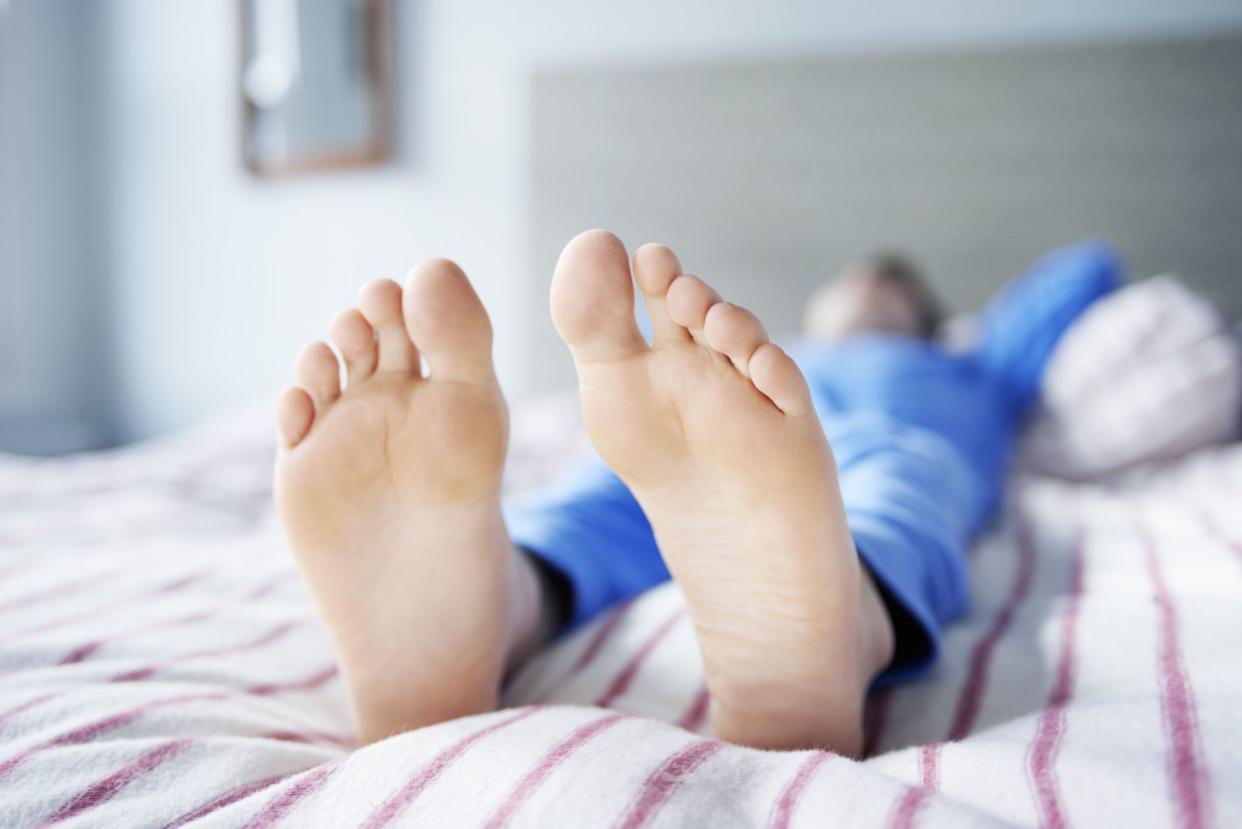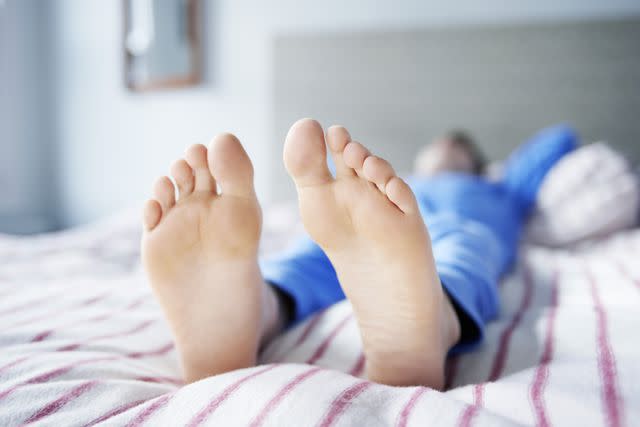Bump on the Bottom of Your Foot: Symptoms, Causes, and Treatment

Tara Moore / Getty Images
Medically reviewed by Adam H. Kaplan, DPM
A bump on the bottom of your foot can result from a variety of causes, including infections, joint problems, and skin conditions. It often leads to pain and discomfort with standing and walking. Treatment will vary depending on the underlying cause.
This article will describe the various conditions that can cause a bump on the bottom of the foot, how it is diagnosed, and treatment options.

Tara Moore / Getty Images
Causes and Treatment
A bump on the bottom of the foot can result from a variety of causes. Some are benign (harmless) while others are related to more serious medical conditions.
Uneven Weight Distribution From Diabetes
Charcot foot is a rare condition characterized by a large, bony lump that forms on the bottom of the foot. It can develop as a serious complication of diabetes caused by chronic inflammation. A Charcot foot causes pain and swelling at the bottom of the foot and increases your risk of developing diabetic ulcers.
Treatment for a Charcot foot that develops from uneven weight distribution of the feet involves putting the affected foot in a cast and avoiding weight-bearing activities on that foot for several months. During this time, you will have to use crutches or a wheelchair to move around.
Gradual progression to normal weight-bearing with prescription footwear or a CROW (Charcot Restraint Orthotic Walker) will begin when your symptoms decrease.
In cases that do not improve, surgery may be performed to:
Remove bone spurs (bony projections along bone edges)
Increase the length of the Achilles tendon (band of fibrous tissue connecting the calf muscle and heel bone) to improve the alignment of the foot and ankle
Fuse the bones of the foot together for better stability
Calluses
Calluses are areas of toughened skin that develop on regions of the body that are subjected to repeated pressure, including the bottom of the feet. Foot calluses can develop from wearing tight shoes, uneven weight distribution due to high or low foot arches, and walking barefoot.
Calluses can be treated by soaking the feet for about 10 minutes, then exfoliating (removing) hardened skin and moisturizing to decrease skin dryness. Surgery to correct the deformity and prevent the callus from coming back may also be needed.
To decrease the likelihood of developing calluses:
Wear properly-fitted shoes.
Don't walk barefoot.
Use shoe orthotics (specially made inserts) to correct foot alignment.
Related: How to Completely Remove a Plantar Callus
Limited Movement in Big Toe Joint
Limited movement in the big toe joint, called hallux limitus, can cause pain at the base of the big toe joint from stiffness and increased pressure. This lack of movement can cause a bone spur to form.
The bone spur can result in a bump on the top of the toe or a bony enlargement at the side of the big toe called a bunion. Imbalanced movement and pressure throughout the joints of the foot may also cause calluses to form on the balls of the feet.
Resting your feet, applying ice, and stretching your big toe can help decrease pain and improve the mobility of your big toe joint. Shoe orthotics or padding can be inserted into shoes to help improve foot alignment.
If joint movement is severely limited, a surgical procedure called a cheilectomy may be performed to remove bone spurs within the big toe joint to improve mobility.
Dyshidrotic Eczema
Dyshidrotic eczema is a skin condition that causes small fluid-filled blisters on the hands and feet, which leads to skin cracking, scaling, and flaking. These blisters can be itchy and painful but typically resolve over time. The exact cause of dyshidrotic eczema is not fully known.
To manage dyshidrotic eczema, avoid exposure to known irritants like metals and harsh chemicals, and treat the blisters with topical creams or oral steroids to decrease inflammation. In severe cases, treatment may include draining blisters or treating with psoralen and ultraviolet light (PUVA).
Plantar Warts
Plantar warts are growths that form on the bottom of the feet from an infection caused by the human papillomavirus (HPV). They most often affect children, adolescents, and immunocompromised individuals. Plantar warts cause pain and swelling under the skin that worsens when applying pressure to the affected areas of the feet.
Most plantar warts resolve within two years and may heal on their own, but plantar wart treatment can prevent them from spreading to others. To break down plantar warts, treatments might include:
Topical salicylic acid
Cantharidin topical medication
Cryotherapy with liquid nitrogen
To prevent plantar warts or a recurrence:
Keep your feet clean and dry.
Avoid sharing socks, shoes, and towels.
Avoid walking barefoot in communal showers and locker rooms.
Also, clean your shower or bathtub with bleach after a recent wart exposure.
Plantar Fibromas
A plantar fibroma is a benign tumor that forms on the arch of the foot. If multiple nodules form, the condition is called plantar fibromatosis or Ledderhose disease.
Plantar fibromas can swell, causing painful tightening of the plantar fascia (a band of tissue that connects the heel bone to your toes), which increases with weight-bearing activities.
Steroid injections into the feet can help decrease swelling and inflammation while shoe orthotics can help improve foot and ankle alignment. Other treatments may include medications such as verapamil or tamoxifen, radiation therapy, and extracorporeal shock wave therapy (ESWT).
Plantar fibromas generally do not resolve on their own and may require surgery to remove the growths, especially if they cause significant pain and difficulty walking.
Bursitis
Bursitis occurs when the fluid-filled sacs (bursa) that cushion joints become irritated and inflamed, causing painful swelling. It can occur in the feet, most often between the metatarsal bones of the forefoot, the bones at the base of the toes, or those at the base of the heel.
Foot bursitis occurs from repetitive stress to the bones of the feet from running and jumping, unsupportive footwear, or foot deformities, which can cause painful bumps on the bottom of the feet.
Treatment for foot bursitis includes steroid injections, stretching, anti-inflammatory medication, ice, shoe orthotics, and rest from aggravating activities.
Haglund’s Deformity
A Haglund’s deformity is an enlargement on the back of the heel bone that can cause irritation and lead to the development of bursitis.
It is often called a “pump bump” because it can develop from repetitive friction and pressure from wearing tight pump-style shoes or other footwear with rigid backs, including ice skates and men’s dress shoes. High foot arches and tight Achilles tendons also increase the likelihood of developing a Haglund’s deformity.
A Haglund’s deformity can be treated by:
Avoiding tight footwear
Using heel pads to decrease friction when wearing shoe
Getting steroid injections
Taking anti-inflammatory medication
Icing
Exercising the calf muscles
Severe cases may require surgery to remove the bone build-up on the back of the heel bone.
Cysts or Benign Soft Tissue Tumors
Benign cysts or soft tissue tumors, such as lipomas, can spontaneously develop on the bottom of the feet. These growths generally are not harmful.
Benign cysts or soft tissue tumors usually do not require treatment but may need to be surgically removed if they compress surrounding nerves or ligaments.
When to Seek Medical Attention
You should see your healthcare provider if a bump on your foot is deep to the skin, swollen, painful, or increasing in size. They will be able to evaluate the bump and determine a diagnosis.
Diagnosis of Bump on Bottom of Foot
A diagnosis for the cause of a bump on the bottom of your foot starts with a physical examination. Your healthcare provider will ask you questions such as:
How long you have noticed the bump
Whether it has changed in size
If it is painful
Whether it is aggravated by certain activities
To determine the cause of the bump, your healthcare provider might order imaging tests, such as:
X-rays
Magnetic resonance imaging scans (MRIs)
Ultrasound
If your healthcare provider thinks the bump may be related to a skin condition, a biopsy of the affected area, in which a sample of tissue is removed for examination in a lab, may be performed to test for:
Takeaway
You may be referred to a specialist if you have foot bumps that are deep to the skin, swollen, painful, and increasing in size to determine if they are cancerous.
Prognosis
Your prognosis (likely outlook for recovery) will depend on the underlying cause of the bump. Conditions like plantar warts, bursitis, and Haglund’s deformities that develop from easy-to-change lifestyle factors have a good prognosis for recovery.
More involved conditions may require more aggressive treatment. Initiating early treatment for any cause of a bump on the bottom of your foot is important for the best possible outcomes.
Summary
A bump on the bottom of your foot can result from a variety of causes, including uneven weight distribution linked to diabetes, calluses, limited big toe joint movement, dyshidrotic eczema, plantar warts, plantar fibromas, bursitis, Haglund’s deformity, and cysts or benign soft tissue tumors.
Treatment varies depending on the underlying cause. It can include simple lifestyle changes such as wearing proper-fitting and supportive footwear, or more involved treatment options, such as steroid injections and surgery. Talk to your healthcare provider about any bumps you notice on the bottom of your feet to make sure you do not have an infection or a more serious medical condition.

